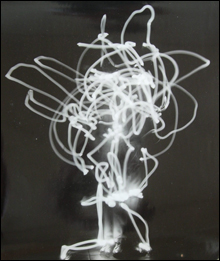Soon after Krasner began dating Pollock, in 1941, she brought him to the Matters’ home in New York’s Tudor City apartment complex. The women talked while the men sat silently. Mercedes Matter left the room to bathe baby Alex, and Krasner joined her, but the men remained quiet. Afterward, Herbert Matter said, “What a wonderful fellow,” as his wife reported in Jeffrey Potter’s 1985 oral biography of Pollock, To a Violent Grave. “I told him they didn’t seem to have had much to say to each other. ‘Not at all. Jackson said this is a terrific time to be living and that gave us enough to think about.’ So they had a perfect communion — always.”
The art here is mostly minor stuff, including lesser works by Krasner, Hofmann, Alexander Calder, and Pollock. The point is the connections: Krasner funneling Hofmann’s ideas to Pollock; Matter funneling his friend Calder’s biomorphic abstraction to Pollock; the Matters helping bring Pollock to the attention of dealer Peggy Guggenheim; Matter’s photos inspiring a Hofmann drip painting.

MAN DRESSING: You can see how Herbert
Matter’s experimental abstract photographs
could have inspired Pollock. |
Landau makes a convincing case that Pollock drew inspiration for his drips and compositions from Matter’s experimental abstract photographs. You can observe the affinity between Pollock’s signature style and Matter’s Abstract Photograms (Electrical Discharges) (circa 1942-’43), which depicts loops of sparking electrical wires, his Abstract Photogram (circa 1942-’43), which depicts silhouetted skeins of wool or thread, and his Ink and Glycerin (1943), a photo of ink dripped into glycerin to create a smoky fluid abstraction that resembles jellyfish. Matter exhibited some of these in May 1943, before Pollock premiered his initial round of poured paintings at Guggenheim’s gallery that November.The exhibit concludes with the Alex Matter “Pollocks” and package. The paintings are mostly dense compositions of layered looping poured paint in various colors. A few resemble little lines of fireworks bursting across a blue page. I’m charmed by one featuring loops of gray green, black, and bluish white punctuated by tiny orange dots. Many feel polished, but none is much bigger than a couple of feet wide, so their effect is modest.
Landau was an early believer in the Matter “Pollocks,” saying in 2005: “This is a very important find in terms of filling in a major gap in Pollock’s œuvre.” Now, she and Cernuschi write that “the evidence, at this juncture, supports only the most tentative conclusions.” Still, they bend over backward to give these “Pollocks” the benefit of the doubt. The materials studies are subjected to a rigorous skepticism — the identifications may be faulty, the dating may rely on bad reference texts, the paints might not be found in good reference texts because they were custom experimental paints shipped from the Swiss art-supply shop of Matter’s brother-in-law, Robert “Robi” Rebetez.
Landau and Cernuschi see the glass as a quarter full: “Seven [of the paintings] actually contained materials whose patent dates or first dates of commercial availability did not lie beyond Pollock’s lifetime.” That, of course, doesn’t prove they’re Pollocks. Landau and Cernuschi point out that the MFA study says the possibility of Pollock’s “having painted, or simply started, some of them cannot, at this point, be categorically excluded.” But when the MFA researchers found post-Pollock materials, they were always in the earliest layers of the paintings. Someone would have to have started them after Pollock died and then let Pollock have his turn.